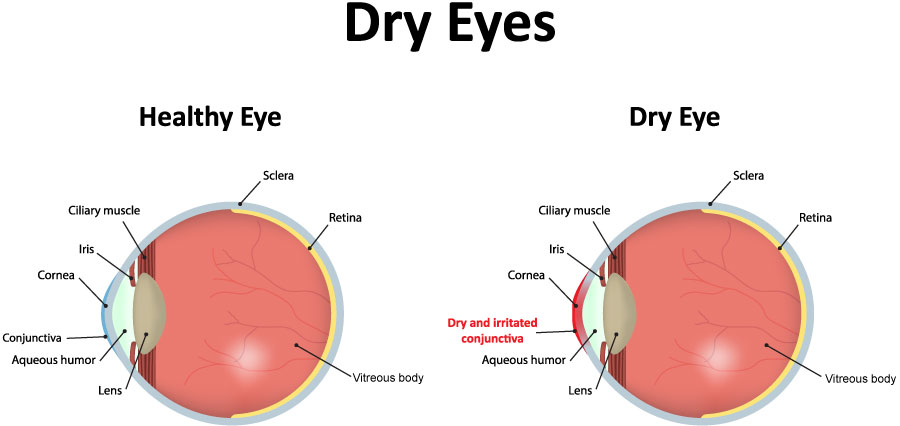What is dry eye?
Dry eye is a common condition that develops when your eyes don’t produce enough quality tears to maintain proper moisture levels. Tears are a crucial component of eye health, as they provide necessary lubrication and help wash away harmful debris. A lack of tears can result in dry, itchy, irritated eyes that make it difficult to perform daily activities.
What causes dry eye?
Dry eye is usually caused by inadequate tear production, either in the amount or quality of the tears. Tears are comprised of three primary layers — the aqueous, lipid, and mucin layers. These components are essentially water, oil, and mucus. When tears contain too much of one component and not enough of others, the eye can dry out. This happens when the glands in and around the eyelids are not functioning properly.
What are the symptoms of dry eye?
Symptoms of dry eye include:
- Gritty, scratchy sensation
- Burning
- Itching
- Redness
- Soreness
- Light sensitivity
How is dry eye diagnosed?
Dry eye must be confirmed through a diagnosis from an eye care professional. It’s necessary for your doctor to examine and test the eye’s tear production and the quality of the tears before a diagnosis can be made. Dry eye tests can also involve testing individual glands to pinpoint the cause of dry eye syndrome.
Dry eye cannot be self-diagnosed. If you have any of the symptoms listed above, it’s important to schedule an appointment to have your eyes examined and tested for dry eye.
How is dry eye treated?
There are a variety of treatment options for dry eye, from simple lifestyle changes to minor surgical procedures. Doctors usually recommend the most non-invasive treatments first — surgical methods are proposed when initial treatments don’t reduce symptoms.
Lifestyle changes can include a simple change to your environmental conditions. Spending less time in front of a screen can help significantly, as can making sure your eyelids are clean after wearing makeup. Wearing sunglasses is also crucial to prevent further symptoms. Your doctor may also recommend nutritional supplements like flaxseed or fish oil.
Artificial tears are also an important part of dry eye treatment. These eye drops, sometimes called lubricating eye drops, can be found in most pharmacies and don’t require a prescription. Regular use can help keep the eye better moisturized.
Prescription eye drops may be recommended for patients who don’t respond to artificial tears alone. Medicated eye drops like Restasis and Xiidra can lubricate the eye while also reducing inflammation. Steroid eye drops can also be used for a more short-term relief from symptoms by treating inflammation more aggressively. Steroids cannot be a long-term solution, however, as using them too frequently can be dangerous and can lead to heightened eye pressure or even cataracts.
Punctal plugs can be used in severe cases of dry eye syndrome. These are very tiny plugs that are surgically placed inside the tear drainage ducts, or puncta. The plugs prevent tears from draining from the eye, which helps maintain proper moisture levels.
Lipiflow® is a newer dry eye treatment that can be performed in a doctor’s office. It focuses on treating the Meibomian gland, which is responsible for producing the lipid component of tears. During Lipiflow® treatment, a device fits over the eye and produces heat to soften the gland. It also applies pressure to try and unclog blockages.
Dry Eye Treatment, Melbourne, FL
Are you seeking relief from dry, irritated eyes? We can help! At Rosanova Eye, our team of dry eye experts can provide fast relief from pain and irritation caused by dry eye syndrome. Schedule an appointment to discuss your options for dry eye treatment in Melbourne, FL today!




